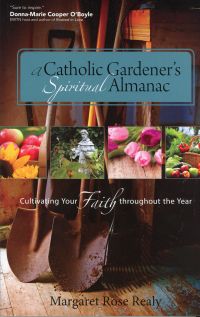 “A Catholic Gardener’s Spiritual Almanac”
“A Catholic Gardener’s Spiritual Almanac”
by Margaret Rose Realy.
Ave Maria Press (Notre Dame, Indiana, 2015).
277 pp., $17.95.
Any Catholic who enjoys gardening will find much inspiration, both spiritual and practical, in this original compendium written by Margaret Rose Realy, a master gardener, retreat leader and Catholic blogger.
Each chapter highlights a particular month’s religious themes, traditions, feasts and special saints and offers unique gardening lore.
For instance, the author presents June as a month of “transformation and new life,” not only for plants but for Christians given the gift of Christ’s love.
Thus during June we honor saints such as St. Boniface (also known as St. Winfrid), the patron of brewers, and St. Botulph of Ikenhoe, the patron of agricultural workers. And June 29 is the feast of the Solemnity of the Apostles, Sts. Peter and Paul; but did you know that the persecution and martyrdom of these two great saints are traditionally symbolized by the checkered fritillary, a “nodding, blood-red flower”? This is the kind of detail that makes “A Catholic Gardener’s Spiritual Almanac” so engaging.
[hotblock]
The June chapter closes with several practical tips on early summer gardening, including how to manage root-bound potted plants that you wish to transplant into the garden to fill bare holes left by winterkill or spring bulbs now gone dormant. For the more ambitious, there’s even a detailed plan for how to create a home garden with the theme of the Stations of the Cross.
Realy’s suggestions of plants to use for each station are fascinating. For instance, for the “Jesus Is Condemned” station, lamb’s ear might be used to symbolize Christ’s meekness;or lily of the valley (“Our Lady’s tears”) could be planted, after the legend that when Mary wept at the plight of her son, this flower sprang from the spot where her tears fell on the ground.
To inspire thoughtful reflection on the 14th station (“Jesus Dies on the Cross”), an appropriate choice might be Jacob’s Ladder, the purple wildflower whose form resembles a delicate ladder of greenery. It evokes the ladder, reaching all the way to heaven, that figured in the biblical Jacob’s dream. Realy also suggests planting white heliotrope, a flower that symbolizes faithfulness in its leaves’ distinctive habit of turning with the sun as it makes its daily journey across the sky.
It’s not surprising that Realy presents harvesting as the theme for the chapter focusing on the month of September. But her take on this is original. She begins with a consideration of the feast of Our Lady of Sorrows on Sept. 15, noting that “the fruit of Mary’s womb, Jesus, was harvested on the cross — the tree of life.” Yet she bore this sorrow with courage and grace, inspiring the author — and readers — to prayerful meditation that God might grant us similar fortitude in such circumstances, if we are called upon to endure them.
Among the interesting lore in this chapter is the story of ladybugs, who Realy says were named for Mary and were earlier known as “Our Lady’s birds,” then as “Lady beetles.” A medieval legend tells how millions of the little spotted red beetles seemed to appear in response to a prayer to Mary, and destroyed a scourge of aphids that threatened crops. The seven spots of the European variety of the ladybug are said to symbolize Mary’s seven sorrows, while their red color echoes her red cloak.
Ten remaining chapters complete this intriguing journey through the months and seasons. Each one offers an original perspective on the intersection of natural and liturgical seasons.
For instance, October’s theme is “Preparing for Winter,” a time of transition; so Realy’s suggested prayer focus for this month includes meditation on accepting inevitable changes in one’s life with gratitude and strength. November, the month of “dormancy and rest,” is an excellent time to contemplate devotional gardens and shrines to beloved saints such as St. Francis of Assisi, the patron of ecology, and St. Fiacre, the patron of gardens. Here, Realy includes a long list of saints and their traditional associated plants.
Among Realy’s many captivating suggestions for the faith-filled gardener is the all-white garden, which when illuminated at night perfectly expresses the “light into darkness” theme of Advent — or the feast of the Transfiguration, celebrated in August. Or consider a Marian garden, which she describes as the most popular type of Catholic garden, perhaps with a rose theme (e.g., red roses for Mary’s sorrows, white for her joys).
The accompanying description of Marian garden plants evokes this touching old tradition:the tulip is known as Mary’s prayer, while balsam is “Mary’s herb” and the oxeye daisy is “Mary’s star.” The blue morning glory is “Our Lady’s mantle,” while lemon balm is “Sweet Mary.”
Four appendices enrich this thoughtful and absorbing book. One explains the various liturgical colors, such as white for the Christmas and Easter seasons, red for Pentecost, violet for the seasons of Advent and Lent, and green for ordinary time.
Another gives instructions for constructing a small, meditative labyrinth in your own yard. A third lists daily and monthly devotions of the church, while another gives detailed instructions on how to dispose of sacramentals and consecrated materials, such as weatherworn garden statues.
“A Catholic Gardener’s Spiritual Almanac” is a treasure trove of meditations, storytelling and practical horticultural advice that will interest anyone, but particularly gardeners, who appreciate the natural world as an eloquent manifestation of the divine.
***
Roberts directs the journalism program at the State University of New York at Albany and has written two books about Dorothy Day and the Catholic Worker.
PREVIOUS: Adulthood nears, but not before the prom, in ‘Paper Towns’
NEXT: ‘Pixels’ proves those all arcade quarters weren’t wasted



Share this story